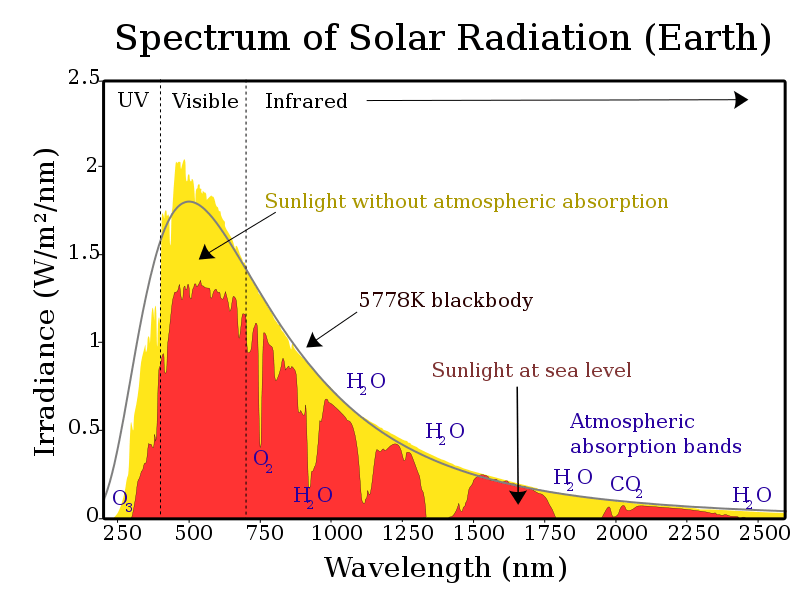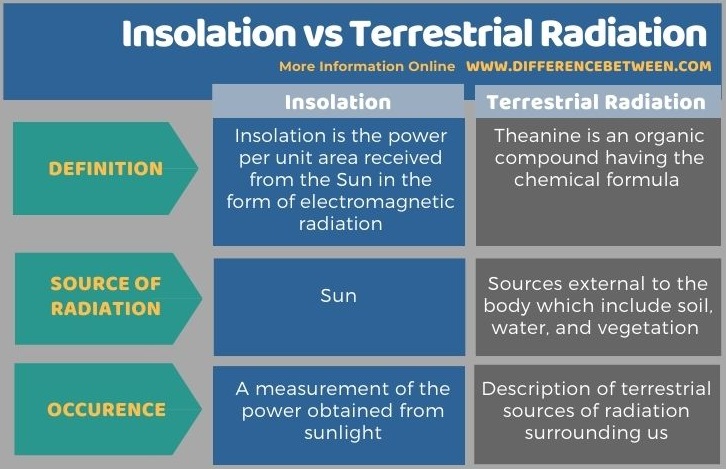Difference Between Insolation and Terrestrial Radiation
Table of Contents
The key difference between insolation and terrestrial radiation is that insolation refers to the measurement of the power of sunlight that is received per unit area of a surface, whereas terrestrial radiation is the source of radiation that is in the soil, water, and vegetation.
Insolation and terrestrial radiation are two different terms regarding radiation energy, and they differ from each other according to the source of energy.
CONTENTS
1. Overview and Key Difference
2. What is Insolation
3. What is Terrestrial Radiation
4. Side by Side Comparison – Insolation vs Terrestrial Radiation in Tabular Form
5. Summary
What is Insolation?
Insolation or solar irradiance is the power per unit area received from the Sun in the form of electromagnetic radiation. Solar irradiation and solar exposure are the other two names for insolation. This power is usually measured as the wavelength range of the measuring instrument. This parameter is typically measured in the unit of Watt per square meter or W/m2. It is the SI unit of this measurement. Often, this parameter is integrated over a given time period for reporting the radiation energy that is emitted into the environment during the time period that we measure isolation. Moreover, solar insolation tends to affect plant metabolism and animal behaviour.

Figure 01: Solar Radiation Spectrum
We can measure the insolation in space or on the surface of Earth through atmospheric absorption and scattering. The insolation in space is a function of distance from the Sun (or the solar cycle). Additionally, the insolation on Earth’s surface depends on the following parameters as well;
There are several different ways to measure insolation. The most common form is total solar irradiance. In addition, we can measure it as direct normal irradiance, diffuse horizontal irradiance, global horizontal irradiance, and global normal irradiance.
What is Terrestrial Radiation?
The term terrestrial radiation refers to sources of radiation that are in the soil, water, and vegetation. Usually, this term is defined as the sources that remain external to the body that can emit radiation. For example, the most common radionuclides we can observe as terrestrial sources of radiation include potassium, uranium, and thorium with their decay products. There are some intensely radioactive sources such as radium and radon, but they only occur in low concentrations. Due to the process of the natural breakdown, or in other words, due to radioactive decay of these radioisotopes, terrestrial radiation occurs.
What is the Difference Between Insolation and Terrestrial Radiation?
Insolation or solar irradiance is the power per unit area received from the Sun in the form of electromagnetic radiation. Terrestrial radiation, on the other hand, refers to sources of radiation that are in the soil, water, and vegetation. So, this is the key difference between isolation and terrestrial radiation. Therefore, insolation is the measurement of the power obtained from sunlight while terrestrial radiation is the description of terrestrial sources of radiation surrounding us. Moreover, in insolation, the Sun is the source of radiation whereas terrestrial radiation involves sources external to the body which include soil, water, and vegetation.
The following infographic summarizes the difference between insolation and terrestrial radiation in tabular form.

Summary – Insolation vs Terrestrial Radiation
The key difference between insolation and terrestrial radiation is that insolation refers to the measurement of the power of sunlight that is received per unit area of the concerning surface, whereas terrestrial radiation is the source of radiation that is in the soil, water, and vegetation. Therefore, insolation is the measurement of the power obtained from sunlight while terrestrial radiation is the description of terrestrial sources of radiation surrounding us.
Reference:
1. “Terrestrial Radiation.” An Overview | ScienceDirect Topics, Available here.
Image Courtesy:
1. “Solar spectrum en” By Nick84 – File:Solar_spectrum_ita.svg (CC BY-SA 3.0) via Commons Wikimedia
ncG1vNJzZmivp6x7pbXFn5yrnZ6YsqOx07CcnqZemLyue8OinZ%2Bdopq7pLGMm5ytr5Wau261zaympZmknryvecCnm2aslae%2Fpr%2FTq6CapF2nrqW1wK2gqKZf